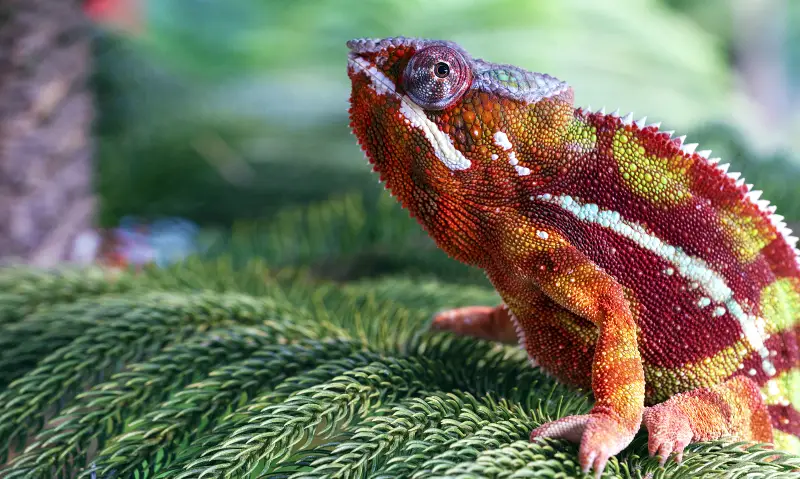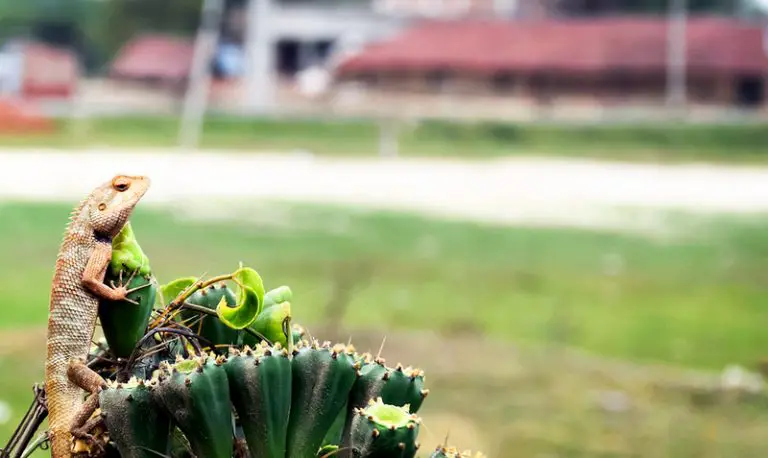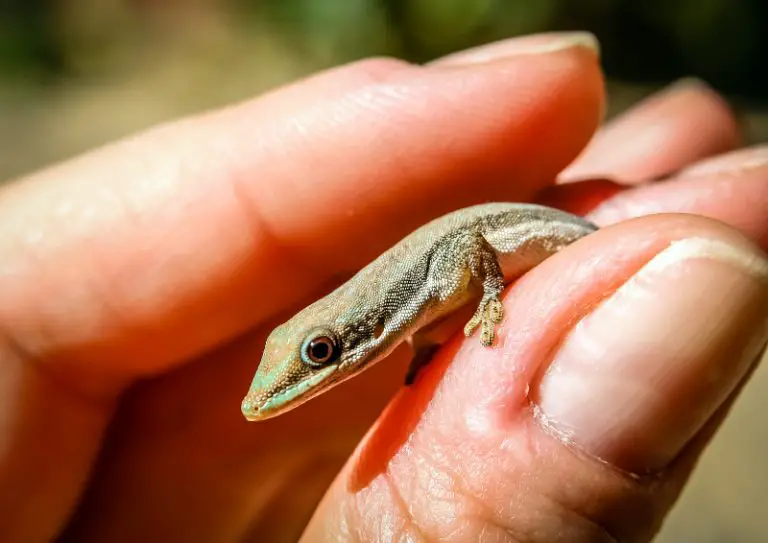How Long Do Chameleons Live & What You Can Do To Make It Longer

If you’re thinking about getting a Chameleon for a pet, let’s talk about how long they might live. The lifespan depends on the species of Chameleon, so let’s discuss. In this article, we’ll share a quick overview of what a Chameleon is. Then, we’ll discuss the lifespans of different Chameleons in the wild and in captivity.

Finally, we’ll share some tips and advice to properly care for your Chameleon and how to elongate their life, so they thrive.
Contents
Table of Contents
What Is A Chameleon?
Did you know there are over 160 species of Chameleons? You can have quite a few of them as pets. For example, you might have a Veiled Chameleon, Panther Chameleon, Jackson Chameleon, or another type. They’re a lizard within the reptile family, also part of the iguana subspecies.
Chameleons are well-known for their coloring. For instance, they have scales in a few different colors: brown, yellow, red, black, tan, or green. Their coloring allows them to camouflage in the wild to hide from predators and prey to catch them easily.
Chameleons prefer tropical forests and deserts in the wild, so it’s important to mimic their habitat as much as possible to one of those biomes.
Also, Chameleons can eat a varied diet, depending on their species, but mostly all eat insects. Some are carnivores, while others are omnivores. In addition, some Chameleons are known to be insectivores because insects are the majority of their diet.
Depending on the species, Chameleons can be big or small. For example, they can grow from 1.1 to 27 inches long and weigh between .02 and 4.4 pounds.
In addition, the lifespan of a Chameleon depends on its species. So, how long does a Chameleon live for?
How Long Do Chameleons Live In The Wild?
Believe it or not, Chameleons have shorter lifespans in the wild than they do as pets. Part of this is because there are certain things they can’t control.
For example, if they can’t find food, they won’t eat. Sometimes the weather is inconsistent and unpredictable. Also, there are predators around.
On average, the typical lifespan of a Chameleon in the wild is about two to three years. However, the average lifespan of a Chameleon depends on the type of Chameleon.
Watch this video: How Long Do Chameleons Live & What You Can Do To Make It Longer
How Long Do Panther Chameleons Live In The Wild?
A Panther Chameleon has a shorter lifespan in the wild than they do as pets. For instance, they may only live for about two to three years in the wild. In addition, females will live shorter than males if they lay eggs.
How Long Do Jackson Chameleons Live In The Wild?
Jackson Chameleons can survive for a while in the wild. For instance, they can live for about eight to ten years in the wild, but it will most likely be on the shorter end. However, females might only live for about four to five years if they lay eggs at some point in their life.
How Long Do Pygmy Chameleons Live In The Wild?
Pygmy Chameleons are one of the smallest Chameleon species. So, you won’t expect them to survive long in the wild. They might live for only about one to two years.
How Long Do Veiled Chameleons Live In The Wild?
In the wild, male Veiled Chameleons can live for about three to five years. Females live a shorter lifespan and only live for about two to three years in the wild.
How Long Do Chameleons Live In Captivity?
On the other hand, Chameleons that live as pets have a longer lifespan. They don’t need to worry about predators and have a consistent source of food. Not to mention that if they get sick, they have access to medication from the vet.
Overall, the average lifespan of a Chameleon as a pet can range from three to ten years. However, this too will depend on the species of Chameleon.
So, how old do Chameleons live until in captivity?
How Long Do Panther Chameleons Live In Captivity?
If a Panther Chameleon is being well cared for as a pet, then their lifespan is longer than it would be if they were in the wild.
For instance, a Panther Chameleon can live for about four to seven years as a pet. In some cases, they could live up to ten years.
However, a female living in captivity who lays eggs may only live for about two to three years.
How Long Do Jackson Chameleons Live In Captivity?
Jackson Chameleons have an average lifespan of about five to ten years when living in captivity. The length of their life will depend on the quality of care they receive.
How Long Do Pygmy Chameleons Live In Captivity?
Pygmy Chameleons don’t live too long in the wild and, unfortunately, you can’t expect them to live much longer in captivity either. Even with proper care, this small Chameleon only has a lifespan of about one to three years.
How Long Do Veiled Chameleons Live In Captivity?
As a pet, you can expect a Veiled Chameleon to live longer than they would in the wild. However, females still have a shorter lifespan than males.
For example, a female Veiled Chameleon in captivity has an average lifespan of up to five years. A male Veiled Chameleon can live up to eight years in captivity.
Click here to read our full guide to how long Veiled Chameleons live.
For a quick look at the average lifespans of some of the different Chameleons species, take a look at the table below.
| Chameleon Species | Average Lifespan In The Wild | Average Lifespan In Captivity |
| Panther Chameleon | 2 to 3 years | 4 to 7 years |
| Jackson Chameleon | 8 to 10 years | 5 to 10 years |
| Pygmy Chameleon | Up to 1 year | 1 to 3 years |
| Veiled Chameleon | 3 to 5 years | 5 to 8 years |
What Can Influence How Long Can Chameleons Live?
Many things can influence how long a Chameleon lives, whether they’re in the wild or captivity.
Gender
First, let’s look at their gender. Unfortunately, females often live shorter than males because they have eggs.
If a female produces eggs at some point in her lifetime, it uses up a lot of her energy, thus shortening her lifespan.
Species
In addition, the species has a lot to do with their lifespan. For example, some species are more hardy than others. Thus they live longer.
On the other hand, the sizing of the different Chameleon species varies. So, smaller Chameleons, such as the Pygmy Chameleon, have a shorter lifespan.
Care
Finally, the type of care they receive has a lot to do with it.
For example, the wild is unpredictable. The weather can vary, such as not giving them enough water to keep the Chameleon hydrated. In addition, some weather conditions may be too harsh.
Also, the wild has predators and sometimes might not have enough food. If a Chameleon can’t find insects near them, they won’t travel far to get them. So, they simply won’t eat.
When it comes to having a Chameleon as a pet, they receive consistent care through feeding and housing. However, if their housing is wrong or they’re stressed too much, then it can shorten your Chameleon’s lifespan.
Tips To Help Your Chameleon Live As Long As Possible
To keep your Chameleon in good shape and help them thrive on living as long as possible, you’ll want to provide them with the best care.
Correct Housing
First, you want to ensure that you have the right setup for your Chameleon. While every species of Chameleon is different, they’re still similar in many ways.
For example, Chameleons are arboreal, which means they’re often found climbing trees and plants. Therefore, they need an enclosure that allows them to climb high, giving them plenty of room to roam.
You’ll need a cage that’s at least 40 inches tall. It will also depend on the size of your Chameleon, but the bigger, the better. For example, the best-sized cage is about 24x24x48 inches.
Then you can add branches, vines, and other plants to allow your Veiled Chameleon to climb to the top of their enclosure.
In addition, they need a cage that’s screen-sided all the way around for proper ventilation. If you get a plastic or glass tank, then your Chameleon may get aggressive (with their reflection), stressed, or scared. Thus, getting sick.
In addition, they need humidity and misting to stay hydrated a few times per day. The temperature in their enclosure should be about 72 to 85 degrees F during the day and no less than 60 degrees F at night. Also, give them a basking spot of at least 95 degrees F every day.
Dieting
In addition, your Chameleon will need a consistent diet. Be sure to research the type of diet your Chameleon needs, depending on their species. For example, some are insectivores while others are omnivores.
Also, their age will factor into the type of food they need. As babies, Chameleons need more protein from live food such as insects. As they get older, you’ll be able to add dark leafy greens and other fruits and veggies to their diet.
Overall, Chameleons need plenty of protein, calcium, and vitamin D to grow and develop well.
Finally, be sure to give them enough time in between feeding to bask so they can fully digest their previous meal. Also, to ensure they’re eating well and not overeating, only put enough food in their enclosure to consume within five minutes per feeding.
Diseases
Finally, Chameleons can get sick just like any other pet. So, you’ll want to bring them to the vet at least once a year for their annual checkup.
If your Chameleon gets sick, that might shorten their lifespan if they don’t get treatment.
Chameleons can get sick from poor care from improper housing or nutrition, getting stressed from poor care or too much handling, and more.
Conclusion
Overall, Chameleons can live a good, long life if they get the proper care. Of course, some species may live longer than others, but you can still enjoy the time you have with them.
Find all our Chameleon guides here. You can also click here to learn how fast Chameleons grow and here for how often they need to eat. Find out everything Chameleons need here.


![How Fast Do Chameleons Grow? [Must Read]](https://allourcreatures.com/wp-content/uploads/2021/12/Pygmy-Chameleon-001-768x513.jpg)



![How Often Do Veiled Chameleons Eat? [Full Eating Guide]](https://allourcreatures.com/wp-content/uploads/2021/12/veiled-chameleon-768x508.jpg)
